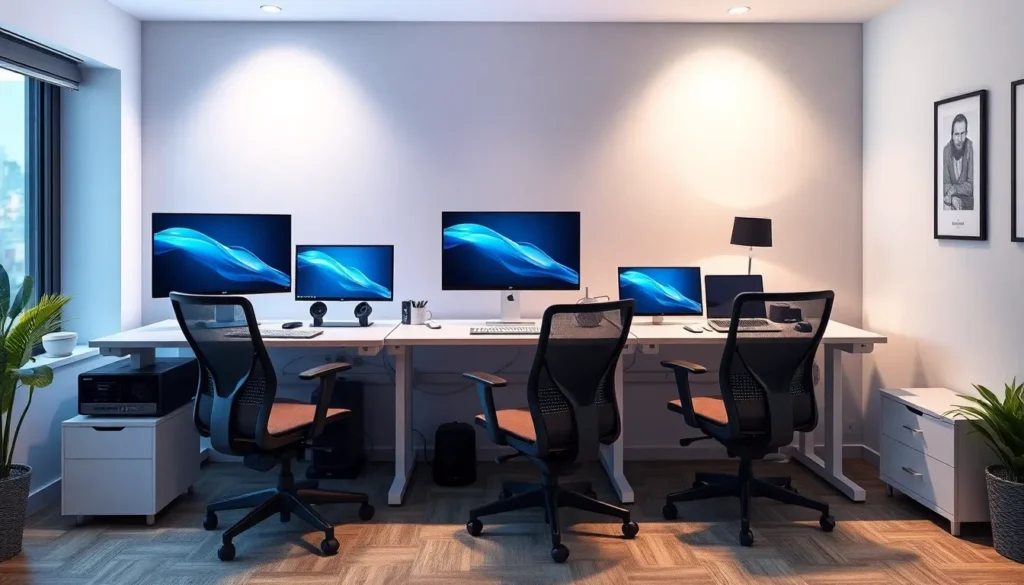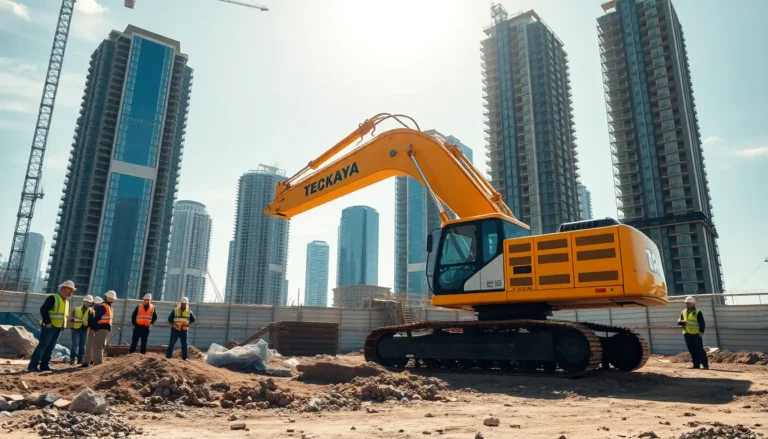Table of Contents
ToggleIn an era where flexibility and efficiency are paramount, expandable desktops are revolutionizing the way people interact with their technology. These innovative setups allow users to customize their workspace, adapting to various tasks and preferences with ease. Whether it’s for a home office, a creative studio, or a bustling corporate environment, expandable desktops offer a dynamic solution that caters to diverse needs.
As remote work continues to rise and the demand for personalized workspaces grows, understanding the benefits of expandable desktops becomes essential. These systems not only enhance productivity but also promote a more organized and aesthetically pleasing environment. Embracing this trend can transform how individuals approach their daily tasks, making work more enjoyable and efficient.
What Are Expandable Desktops?
Expandable desktops refer to customizable computer setups that offer flexibility and adaptability in workspace organization. These desktops enable users to modify their work environments by adding or rearranging components according to their specific needs. Key features of expandable desktops include modular hardware, adjustable layouts, and integrated technology solutions.
Modular hardware allows users to choose various components, such as additional monitors, keyboards, and storage options. This adaptability enhances productivity by enabling seamless multitasking and efficient space management.
Adjustable layouts facilitate different work styles. Individuals can easily switch from a traditional desk setup to a standing configuration or create collaborative spaces for team projects. Such versatility promotes comfort and reduces the risk of strain during prolonged use.
Integrated technology solutions often accompany expandable desktops. Tools like docking stations, wireless charging pads, and cable management systems enhance organization and improve user experience. These advancements contribute to a clean and efficient workspace, essential for maintaining focus and productivity.
Overall, expandable desktops offer a modern approach to work environments, catering to individual preferences while supporting the dynamic nature of contemporary work practices.
Benefits of Expandable Desktops

Expandable desktops offer numerous advantages that enhance user experience in modern work environments. Their customizable nature leads to increased flexibility and cost-effectiveness.
Increased Flexibility
Increased flexibility characterizes expandable desktops. Users can easily modify their setups by adding components or rearranging layouts to suit specific tasks. This adaptability meets various work styles, fostering an ergonomic workspace that enhances productivity. For example, individuals can swap out a standard monitor for a larger display or integrate additional storage solutions as needed. Such configurations allow users to transition seamlessly across multiple projects, facilitating multitasking without disruptions.
Cost-Effectiveness
Cost-effectiveness stands out as a major benefit of expandable desktops. Users invest in components that align with their needs, reducing unnecessary expenses on complete systems. By upgrading individual parts over time, they can extend the lifespan of their setups, minimizing the need for frequent replacements. For instance, replacing a graphics card instead of purchasing a new computer saves substantial costs. This approach enables businesses to optimize their budgets while ensuring that employees have access to the latest technology as required.
Types of Expandable Desktops
Expandable desktops include various configurations that enhance user experience and adaptability. Two primary types are modular systems and customizable options, each offering distinct advantages.
Modular Systems
Modular systems consist of interchangeable components that users can piece together for their unique needs. They include parts such as monitors, keyboards, and storage units. This design allows for easy upgrades and replacements, facilitating continuous improvements without the need for a complete overhaul. For example, adding a larger monitor can significantly improve multitasking capabilities, while opting for ergonomic keyboards can enhance comfort during long work sessions. Modular systems promote an organized workspace by allowing users to configure components based on activity type, from gaming to professional tasks.
Customizable Options
Customizable options refer to the ability to tailor an expandable desktop setup according to individual preferences. These include adjustable desks, shelving solutions, and aesthetic enhancements like color themes. Users can select furniture that suits their space and workflow, such as standing desks that promote movement and reduce physical strain. Integrated technology options, like USB hubs and cable management systems, further contribute to a personalized workspace, ensuring a clean and functional environment. Customizable options empower users with control over their work setup, making it easier to adapt to changing tasks and preferences.
How to Choose the Right Expandable Desktop
Selecting the right expandable desktop requires careful consideration of various features and individual needs. Understanding both key features and personal requirements ensures an optimal workspace.
Key Features to Consider
- Modular Components: Prioritize systems that incorporate modular hardware, allowing easy upgrades and replacements. Selecting a setup with interchangeable parts enhances productivity by supporting multitasking.
- Adjustable Layouts: Choose desks that offer adjustable heights and configurations. This capability accommodates multiple work styles, promoting comfort and preventing strain during extended use.
- Integrated Technology: Look for setups equipped with integrated solutions, such as docking stations and cable management systems. These features facilitate a cleaner workspace, contributing to efficiency and organization.
- Expandability Options: Opt for desktops that provide straightforward ways to add or rearrange components. This flexibility ensures the workspace evolves with changing tasks and needs.
Assessing Your Needs
- Work Style: Identify the primary tasks to determine suitable features. For example, a user focused on graphic design might require higher-end monitors and drafting surfaces, while a programmer may prioritize keyboard and mouse ergonomics.
- Space Availability: Evaluate the available space in the work area. Space constraints may dictate the choice of laptop or desktop configurations, influencing the number of components that can be integrated.
- Budget Considerations: Establish a budget to guide decisions on components. Focus on investing in essential features that provide the greatest return in productivity and efficiency.
- Future Upgrades: Anticipate future needs by considering the compatibility of components. Selecting setups with a clear path for upgrades avoids obsolescence and ensures longevity in the investment.
Expandable desktops are revolutionizing how individuals approach their workspaces. By offering customizable and flexible solutions, these setups cater to diverse work styles and preferences. The ability to modify components not only enhances productivity but also fosters a more organized and visually appealing environment.
As remote work continues to grow, the importance of adaptable workspaces becomes increasingly clear. Users can create ergonomic setups that reduce strain while accommodating various tasks. With cost-effective options available, investing in expandable desktops is a smart choice for both individuals and businesses looking to optimize their work environments. Embracing this modern approach can lead to improved efficiency and satisfaction in daily tasks.







